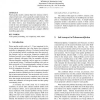Free Online Productivity Tools
i2Speak
i2Symbol
i2OCR
iTex2Img
iWeb2Print
iWeb2Shot
i2Type
iPdf2Split
iPdf2Merge
i2Bopomofo
i2Arabic
i2Style
i2Image
i2PDF
iLatex2Rtf
Sci2ools
MIC
2003
2003
Modelling Salt Transport in Baltic Basins
Water quality models combine fluid-flow relations with biological regressions, all on a spatially complex domain. For many applications, a computationally simple lumped parameter model with regressed parameters suffices, while for others where a more fundamental approach may be worth the extra development and computational effort. A simple example modelling the transport of salt in interconnected basins is used to illustrate and compare different modelling approaches. KEY WORDS water quality modelling, size complexity, PDE, FEM
| Added | 31 Oct 2010 |
| Updated | 31 Oct 2010 |
| Type | Conference |
| Year | 2003 |
| Where | MIC |
| Authors | Magnus Dahl, David I. Wilson |
Comments (0)

